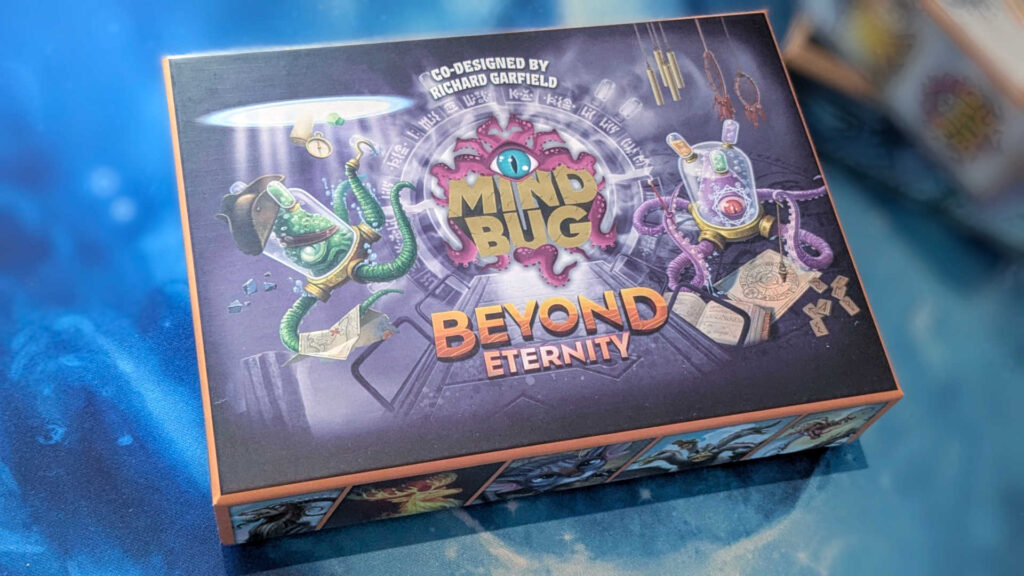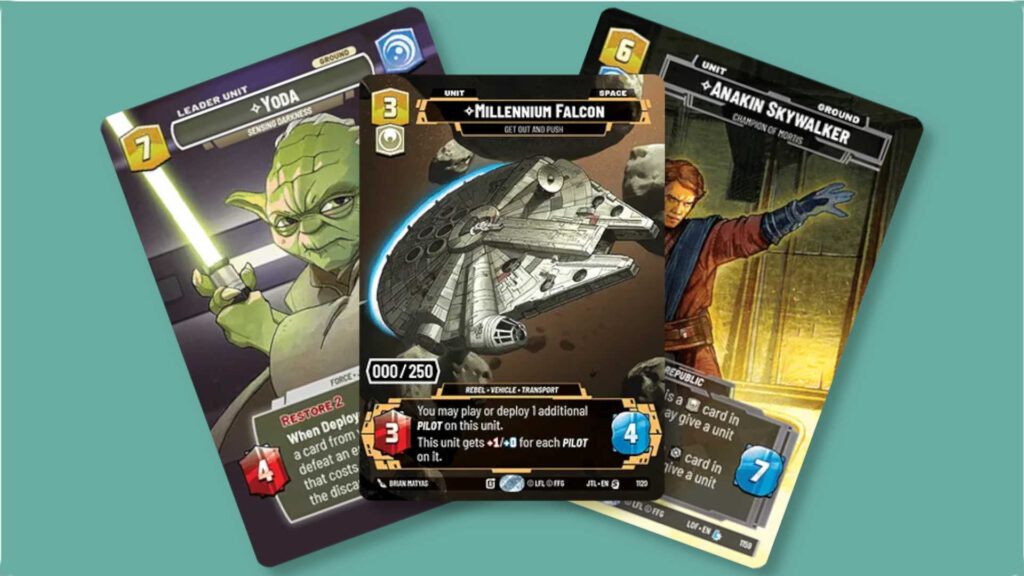It’s no secret that we’re huge fans of Mindbug here at Card Gamer; our reviews of the first game and the standalone expansion, Mindbug: Beyond Evolution both offer solid evidence of that. With Mindbug: Beyond Evolution bringing evolving creatures to the game, what does Mindbug: Beyond Eternity add to the already compelling Mindbug formula, and how does it compare to the other titles in the range? Let’s find out!
Table of Contents
ToggleGetting Started With Mindbug: Beyond Eternity
One of the coolest things about the Mindbug titles is that, if you just want to jump in with either of the expansions if their particular twist on the gameplay appeals to you, there’s no problem with doing that. With three Mindbug sets currently available and each offering their own unique experience, you can either play using just one of them, or combine sets if you choose, to create a hybrid, Frankenstein’s Monster of a Mindbug experience!
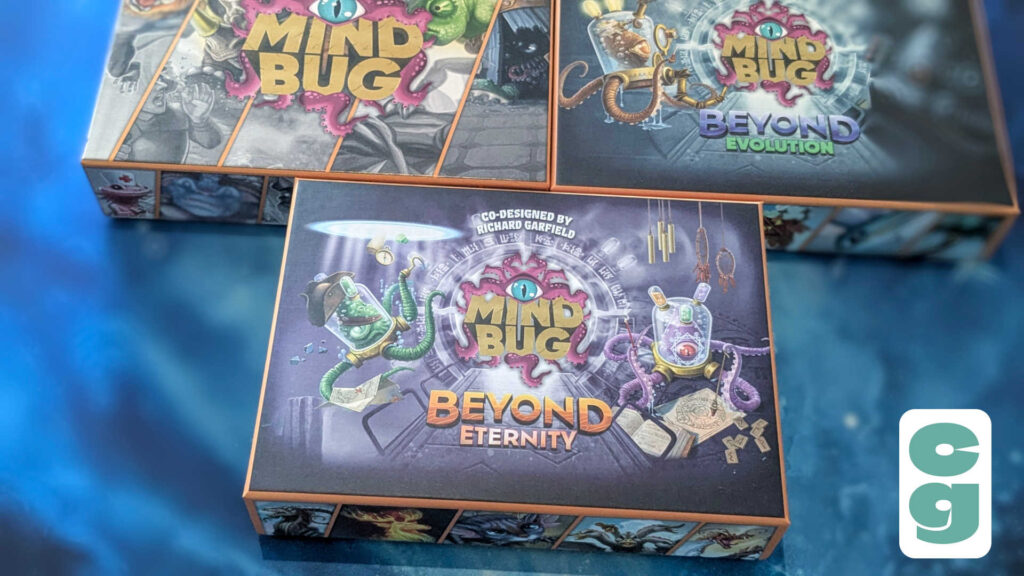
However, if you just want to use Mindbug: Beyond Eternity, all you need is the one box and an opponent, and you’re ready to get going. Without the evolving creatures of Mindbug: Beyond Evolution, setup is even easier in Mindbug: Beyond Eternity, and works in exactly the same way it does in the base game of Mindbug (also known as Mindbug: First Contact). Using the single deck of 48 creature cards, players are dealt 10 cards each to make their personal deck for the game. Each player then draws five cards each as their opening hand. Each player also takes two Mindbug cards and the matching life tracker, setting the dial to 3.
How to Play Mindbug: Beyond Eternity
Just like the other Mindbug games, it’s incredibly easy to play Mindbug: Beyond Eternity; each turn, the active player will either play a creature card from their hand, or use a creature they already have in play to attack the other player.
If they play a card from their hand, they follow the Play trigger keyword ability if the card has one. However, their opponent can choose to use one of their two Mindbug cards to take control of a creature being played, at which point the creature is placed under their control, and the active player gets another turn immediately. The Mindbug used is turned over; each player has two Mindbugs per game they can use in this way. Note that, if the creature being controlled does have the aforementioned Play keyword, the new controlling player activates it, not the player who originally attempted to play the card.
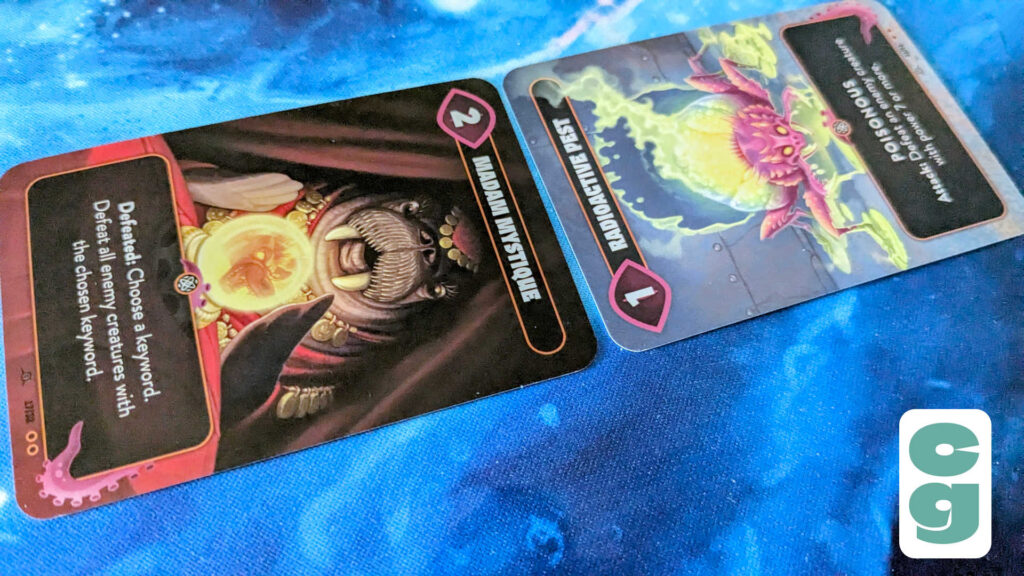
If attacking the other player, they choose a creature to do so, and the opponent gets a chance to block if they choose. If blocking, the opponent chooses a creature to block with; the creature with the highest power wins, and the losing creature is sent to the owner’s discard pile (unless they have the Tough keyword – more on that shortly!).
In the example above, Madam Mystique would win the combat, with two power compared to the Radioactive Pest’s one. However, Radioactive Pest has Poisonous, so Madam Mystique would also be defeated. Madam Mystique also has a trigger ability, which occurs when she is defeated (her owner chooses a keyword, and defeats all enemy creatures with that keyword).
If the defending player doesn’t block, they move their life tracker down one point; if this reaches zero, they lose the game. Simple, right? Those are the basics, and they apply for each edition of Mindbug. But what are the differences to Mindbug: Beyond Eternity specifically?
What’s New in Mindbug: Beyond Eternity?

Along with two new, named Mindbugs (Captain Tentacles and Commander Octavia), there’s a big new mechanic in Mindbug: Beyond Eternity, in the form of Boost. When a creature has Boost, it can be used to take cards from a discard pile (either their own, or their opponent’s), and place them face down under a creature; a creature’s power is boosted by one per card kept underneath it in this way.
Boost is triggered in different ways depending on the creature’s printed text; sometimes, it’s triggered on play, but it can also be triggered when the creature attacks, or even when it’s defeated. The card’s text specifies the number of cards used to Boost, and whether or not it applies to the creature with the Boost ability, or any creature in play.
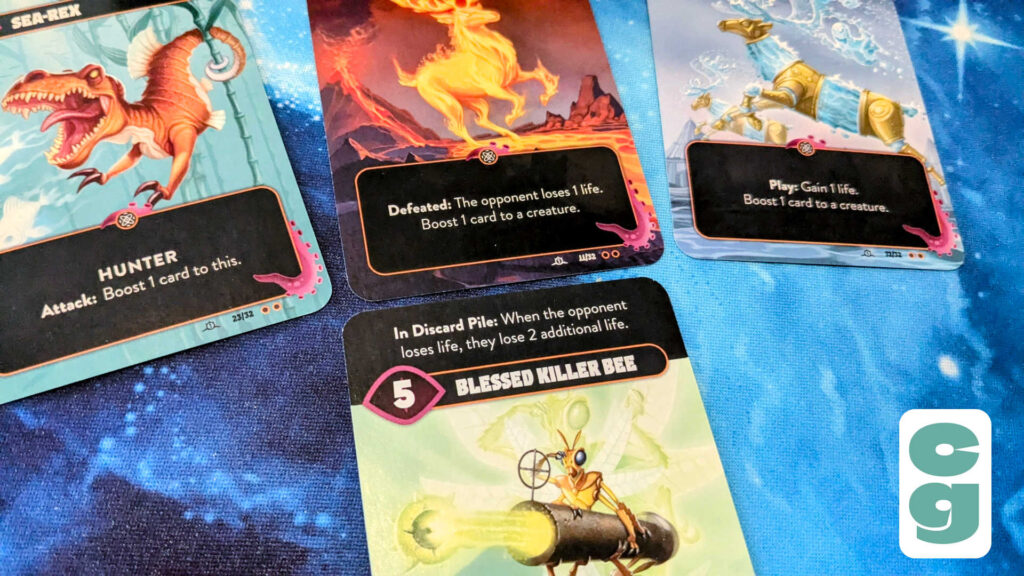
There’s also a creature or two that interact with discard piles in different ways without Boost, and it does also feel as if there’s a very strong focus on the different keywords and new abilities in Beyond Eternity as well.
Otherwise, the core mechanics of Mindbug remain the same, including the keywords Frenzy (allowing a creature to attack twice per turn, providing it survives the first attack!), Hunter (which allows the attacking player to choose an enemy creature who must block), Poisonous (which defeats an enemy creature no matter the outcome of combat), Sneaky (which can only be blocked by other creatures with the Sneaky keyword) and Tough (which exhausts a creature, by turning its card sideways, the first time it’s supposed to be defeated, only defeating it completely if it is already exhausted).
Note that evolving creatures are kept separate and contained to the Beyond Evolution expansion; this means that, despite the added complexity and strategic opportunities that the Boost mechanic adds to the game, players aren’t overwhelmed by dealing with evolving and Boost, unless they choose to mix the sets together.
Is Mindbug: Beyond Eternity Fun to Play?
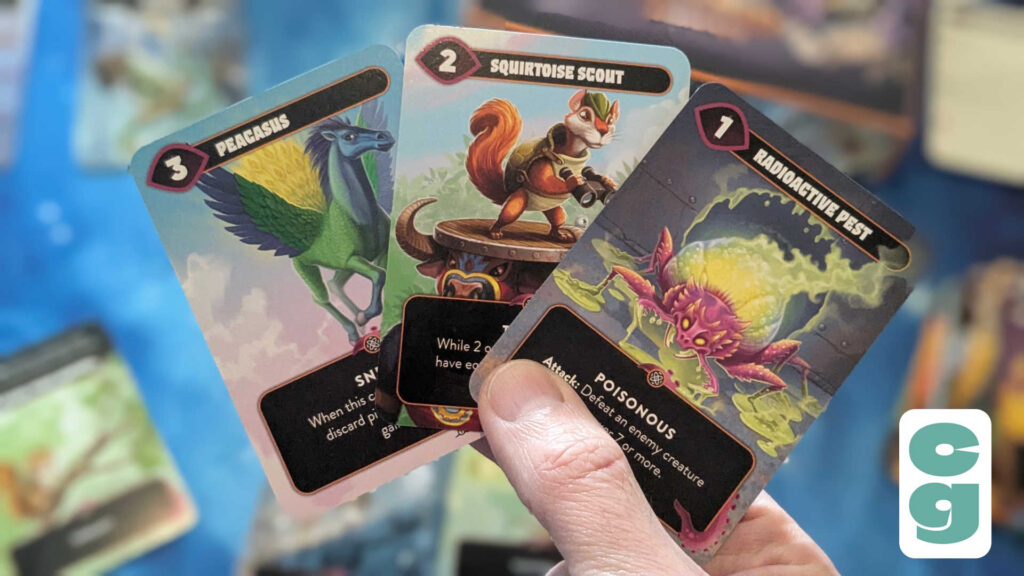
It absolutely is, yes; the strength of Mindbug in general is the ease of being able to pick it up and play it almost immediately. Yet there’s also a surprising depth to its mechanics, despite the simplicity the game has on a surface level. The Boost mechanics of Beyond Eternity do add further complexity to the basic Mindbug formula, and the manipulation of discard piles, along with the timing of using Boost abilities, does make it perhaps the most complex of the three currently available Mindbug titles. Yet it remains an accessible, easy to learn, and incredibly fast paced game overall.
It’s also worth noting that the creature design and artwork is just as good in Beyond Eternity as in the other Mindbug sets, with some genuinely imaginative and amusing illustrations. Though Beyond Evolution took the overall feel in a very bio-mechanical direction, in Beyond Eternity there are a lot of elemental and supernatural powers on display amongst its unique menagerie.
As I’ve mentioned in my other Mindbug reviews, the game does a fantastic job of feeling like a much bigger scale and more complex trading card game (or TCG), such as Magic: The Gathering, pared down to basic, essential mechanics, yet losing no charm or fun in the process. It’s a game that has, in our humble opinion, a great deal of appeal to players of all ages and experience levels; though we’d still recommend the basic Mindbug for the most casual (or truly inexperienced) players, it’s not as if there’s overwhelming complexity to Mindbug: Beyond Eternity.
The Card Gamer Verdict
The Mindbug games are built on an incredibly strong set of basic mechanics; both Mindbug: Beyond Evolution and Mindbug: Beyond Eternity are a great way of refining the basic formula, without each expansion feeling too complex in isolation.
Though it’s slightly less beginner-friendly than either of the previous games, it still feels pretty accessible, and retains the feel of being an epic card game in a small, aesthetically pleasing (and inexpensive) package.
On the basis of its new Boost mechanic, we’d still recommend Mindbug (aka Mindbug: First Contact) as the best entry point for new players, but Mindbug: Beyond Eternity is great to add to an existing Mindbug collection (especially as the cards can be mixed with the other sets), or for players more used to the mechanics of trading card games.
Just like the other Mindbug titles, Beyond Eternity is one of the best two-player card games available at present, and we can’t wait to see where publisher Nerdlab Games take Mindbug next.
For more on other standalone card games which we’d highly recommend, take a look at our feature on Street Fighter: The Deck-Building Game, or our review of the excellent Jaipur!


